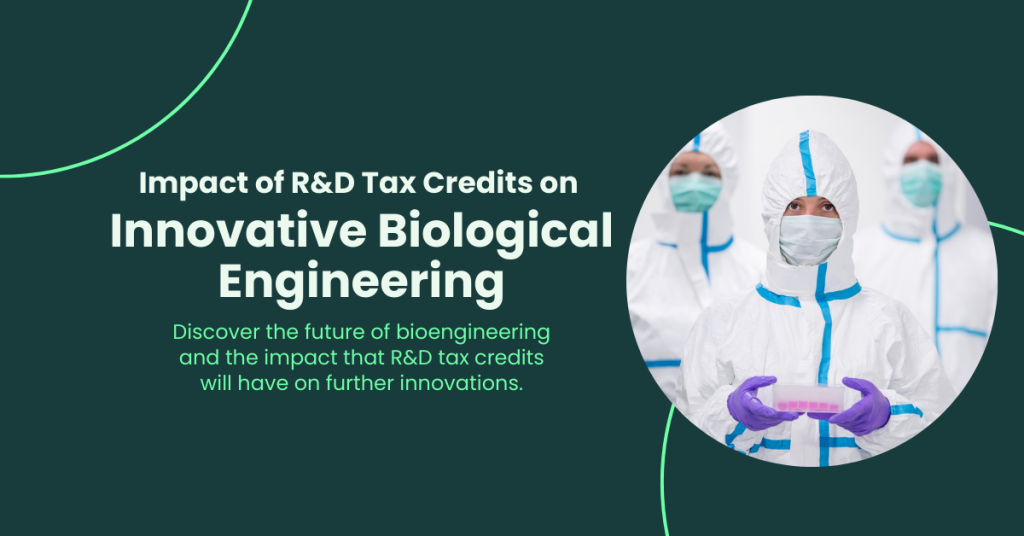Impact of R&D Tax Credits on Innovative Biological Engineering

Unravel the power of R&D tax credits and how they inspire innovation in bioengineering. Discover how the progression of biological engineering improves health, increases agricultural productivity, and aids in managing a more sustainable environment.
When discussing the prospect of biological engineering, many people will think about artificial joints or the latest superhero movie where of course, there is typically someone relying on biotechnology to survive. For innovative minds however, the discussion opens up to synthetically developed immunisations, culture based food production, or even the genetic coding of extinct animals and plant life.
You see, behind the word bioengineering, there is a world of innovative advancement that seeks to improve the world and its inhabitants. Through the investment in research and development, biological engineering is making effective changes across a variety of industries – some of which we use without even realising.
So join us as we explore the role of biological engineering and how R&D tax credits can breathe new life into innovation.
The Role of Biological Engineering
The primary role of bioengineers is to work with biological material in order to overcome issues across a range of sectors, some of the most prominent being healthcare and the environment.
Their ability to combine engineering with science and technology allows bioengineers to develop products that provide long-term benefits, be it reducing the cost and maintenance of a pre-existing item, or producing a safe solution to a widely known problem such as disease. Innovations in bioengineering and life sciences, driven by R&D tax credits, enhance healthcare through advanced medical devices and support SMEs in achieving breakthroughs while ensuring compliance with HMRC regulations.
Examples of Historical Bioengineering Breakthroughs
Given the scope of biological engineering, the impact across various sectors is immense. In order to give you an insight into how prolific the accomplishments actually are, here are some of the greatest bioengineering breakthroughs that changed the course of history:
- Development of the polio vaccine
- Production of sustainable lab grown food
- Development of the MRI machine
- Production of biofuels
- Development of bioremediation techniques
- Development of gene editing technology
Impact of Historical Bioengineering Innovations
While biological engineering is still in its infancy, their innovations have seen an incredible impact on a global scale.
For instance in the early 1980’s, there between 300,000 and 400,000 reported cases of paralytic polio per year. The year 2020 however, saw only 1,873 reported cases, a striking contrast that is due wholly to the bioengineering development of the polio vaccine.
Source: Our World in Data
With each major innovative step made in biological engineering, the world’s population experiences an improvement in the way of life. Whether the advancement is made in medicine or it’s made in environmental management, it ultimately makes a significant change – whether we are fully aware of it or not.
The Future of Biological Engineering
While the world experiences an unprecedented advance in technology, the future of bioengineering is in a prime position to deliver groundbreaking advancements that will transform a wide range of industries – and ultimately our everyday lives.
Due to increasing demands for more affordable and accurate healthcare, along with necessary environmental solutions, it’s safe to say that the future of bioengineering currently holds a spotlight on these three sectors:
- Healthcare
- Environmental management
- Biotech and bioinformatics
To provide an insight into how bioengineering may impact these sectors, we decided to do a deep dive in order to showcase the future trends of biological engineering.
Future Trends in Bioengineering: Healthcare
Known as medi bioengineering, experts in the field are using research and development to achieve never before seen advancements in the healthcare sector.
The idea behind biological engineering in the healthcare industry is to provide well rounded therapies, diagnostics and treatments that improve patient care.
Whether that means decoding genetics to better target illness or enhancing pre-existing medical items in order to provide greater care and improve quality of life, there are an array of projects that seek to advance healthcare. The following list highlights some of the likely trends in the future of medi bioengineering:
- Personalised medicine (using gene editing and analysis)
- Advanced tissue engineering (regenerative medicine)
- Development of biocompatible medical devices and implants
By making advancements in these areas, medi bioengineering has the ability to once again transform the way in which healthcare is administered, leading to a new era in medicine.
Future Trends in Bioengineering: Environmental Management
The overall purpose of biological engineering in environmental management (sometimes referred to as environmental biotech) is to restore ecosystems, reduce pollution and to promote overall sustainability.
Considering the increase in natural environmental damage due to climate related extreme weather and wildfires, the race is on to develop advancements in environmental management. This is where bioengineering can have a great impact with innovative research and development, especially with these likely future trends:
- Advanced development of bio-based materials
- Use of synthetic biology (for carbon capture and renewable energy)
- Development of microbial solutions (for waste management)
By working to find solutions in this area, bioengineering has a huge part to play in how we can reduce our carbon footprint through biological means. Similarly there is a great opportunity for them to explore how to develop materials that aren’t going to cost the literal earth we inhabit.
Future Trends in Bioengineering: Biotech & Bioinformatics
Through data analysis, computational tools and biotechnical applications, the premise of biotechnology and bioinformatics is to advance biological research.
While this may seem a lot broader than the other sectors that we’ve covered, that’s because biotech and bioinformatics typically focus more on the engineering of supportive software that aids in the advancement of other biological research. This means that each industry that incorporates bioengineering likely relies on the advancement of biotech and bioinformatics so that they may accomplish the seemingly impossible.
Take these future trends in biotech and bioinformatics for example:
- Integration of AI (for predictive modelling & drug discovery)
- Advancement of genomic data analysis
- Expansion of CRISPR (for disease treatment & prevention)
Due to the large scope of these future trends, it’s likely that biotech engineers will impact a range of different industries due to the research and development that they put in not only to support other innovations, but to innovate themselves.
How to Maximise R&D Tax Credits for Biological Engineering
When considering the amount of research and development that goes into bioengineering, it’s easy for many companies to feel unnerved about the possible financial burden. This is where R&D tax credits are able to help.
As a government incentive to increase innovation, R&D (research and development) tax credits are available to businesses that work on projects that aim to find solutions to scientific or technological uncertainties within their industry.
Here’s an example of how R&D tax credits can benefit businesses investing in bioengineering advancement:
- Business fosters an environment of innovation
- Allows business to invest in innovation without financial burden
- Business solves uncertainty in sector with bioengineering innovation
- Innovation improves businesses competitiveness in global market
What is the R&D Tax Credit Eligibility Criteria
Considering the scope of benefits that R&D tax credits have to offer the businesses investing in bioengineering innovation, they come with a range of specific eligibility criteria to ensure the validity of the research and development.
First off, let us note that HMRC’s definition of research and development is a project that sets out with the aim to overcome an industry specific scientific or technological uncertainty that could not otherwise be overcome by an expert or individual in the field.
Typically an R&D project will involve a range of research and development activities that seek to produce one of the following as a way of overcoming the initial uncertainty:
- Product
- Software
- Technique
To ensure the validity of your R&D tax credit claim, it’s important to document the initial aim and the objectives of your project. This should highlight the uncertainty and why it could not be overcome by an individual.
What is Qualifying R&D Tax Credit Expenditure for Bioengineering
On top of your project’s aims and objectives, you should also begin keeping records on the costs your project obtains. This will help you to later determine your qualifying expenditure.
While qualifying R&D expenditure looks similar across all industries, there may be additional costs that could be missed unless looking at qualifying expenditure for your industry and the nature of your project. So to make this a little easier, here is a list of the qualifying expenditure for biological engineering:
- Direct R&D staff costs (including Class 1 NIC and pension funds)
- Externally provided staff costs
- Subcontracted R&D
- Consumable items
- Software used directly in R&D
- Prototypes
- Clinical trial volunteer pay (pharmaceutical industry and research organisations only)
Large companies may also be able to claim R&D tax credits for contributions made to independent research, but the recipient of the funding must be made to one of these four kinds of qualifying bodies:
- A charity
- A higher education institute
- A scientific research organisation
- A health service body
Businesses may also make an R&D tax credit claim for collaborative work with either another company or a kind of research institution. When collaborating with a research institution, only the business can make a claim, not the organisation. When two businesses collaborate on research and development, both may make an R&D tax credit claim, but only for the costs that they themselves incurred during the course of the project.
What are the Common R&D Tax Credit Pitfalls to Avoid
Considering the complexity of R&D tax credits, it’s easy to make a few mistakes throughout a claim. While HMRC understands that first time claimants may have estimated figures at the start of their project, some other common mistakes can lead to enquiries that could have serious repercussions.
As it is our job to ensure that your claim meets HMRC’s guidelines, we wanted to highlight three of the most common mistakes that are made when compiling an R&D tax credit claim:
- Creating a claim for the wrong R&D scheme
The R&D scheme that you claim under is defined by company size, income and the nature of your R&D unless your accounting period begins before or after April 1st 2024 - Not keeping up to date with changes to R&D tax credit policy
We keep our community updated through our blog and our social media - Not providing sufficient evidence of R&D projects
Our detailed R&D documentation guide outlines the evidence you’ll need for your claim
How Can Alexander Clifford Help With R&D Tax Credit Claims?
As leading R&D tax credit consultants with extensive knowledge on R&D tax credit policy, our experts have submitted over 2,400 claims to HMRC.
With a dedication to simplifying the claims process, our experts are on hand to manage your claim from start to finish.







